Last week I wrote about my talk at the National Conference on Urban Design, and using street design to improve the subjective safety of cyclists. The conference was held in Oxford and it was fantastic to be able to talk about riding a bike whilst outside in the city hundreds of people were doing just that.
I'd not been to Oxford before, and I wasn't sure what to expect. I half imagined there would be dons in capes on rusty uprights smoking pipes as they darted to the Library by bicycle. But then I realised that's Cambridge. Instead I found a busy city with busy streets, full of conflicting demands for space and supremacy. Some of the city street's carriageways felt unnecessarily wide - and subsequently fast - whilst I was surprised to see quite a bit of on-street parking in the historic city centre. The main road through the middle of the city - the High Street - is an essential bus and bicycle route that allows hundreds of people to come and go without using a car, but the pavements were incongruously narrow and walking here was not exactly a pleasant experience (especially alongside Magdalen College). The cycle lanes there were also narrow, which is why I couldn't understand why so much space had been left over to encourage fast driving. The street design felt very dated, to be honest.
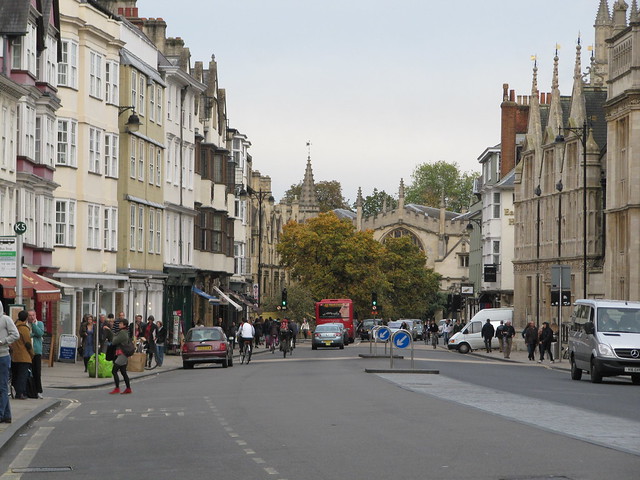

Even the New College Lane passing beneath the so-called "Bridge of Sighs" - surely one of Oxford's most photographed locations - looked decidedly tired with gaudy double yellow lines splashed either side of the narrow road scarred by utility trenches. Seeing as New College Lane is a little-used backway predominantly populated with pedestrians and bicycles, why hasn't this street been surfaced with some beautiful paving, and made in to shared space already so that more people can enjoy it without feeling that what little motorised traffic there is here must take priority?
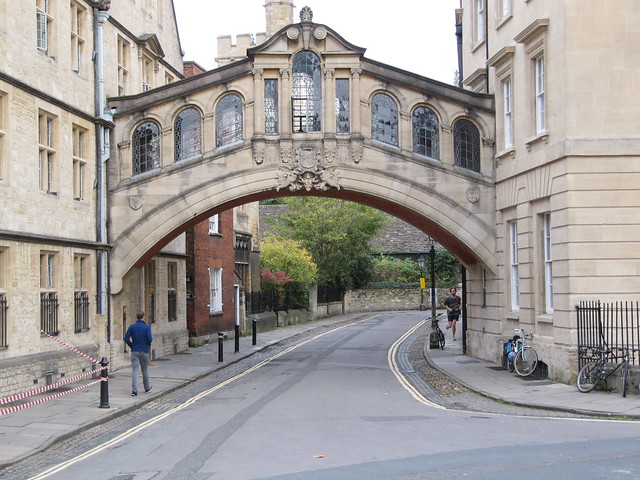
Still, there are certainly plenty of cyclists to be seen in Oxford and it's charming to see the predominantly young two-wheeled population of the city going about their ways. Most unusually for the UK upright bicycles ruled the day and many bikes were free-locked in the street - something you'd never see in London - which helped to lend a care-free attitude to the city's unencumbered cyclists. The look seemed to be college sports kit, or book bags and long scarves as opposed to high vis vests and helmets, which was refreshing.

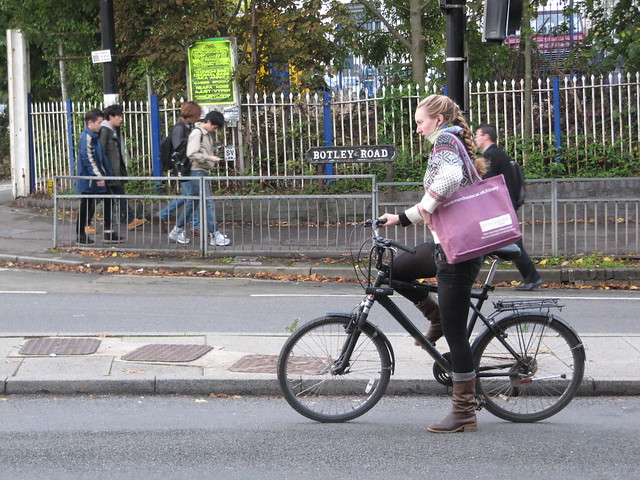

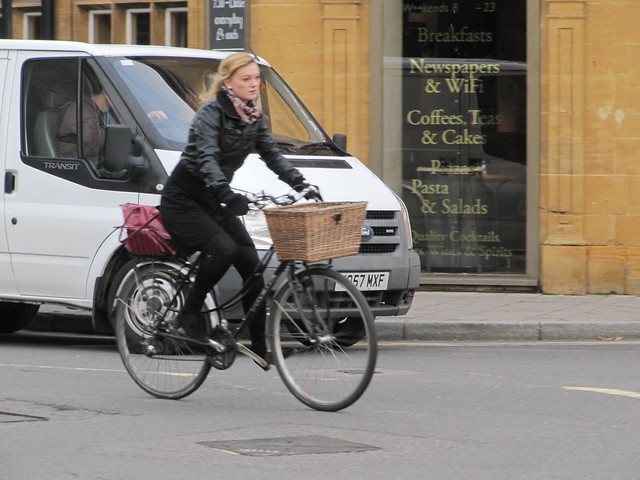
Crocodiles of bicycles weaved their way past Oxford train station, the forecourt of which was littered with a mixture of smart commuter frames parked up for the day and the detritus of decades of uncollected dead and dieing bicycles.
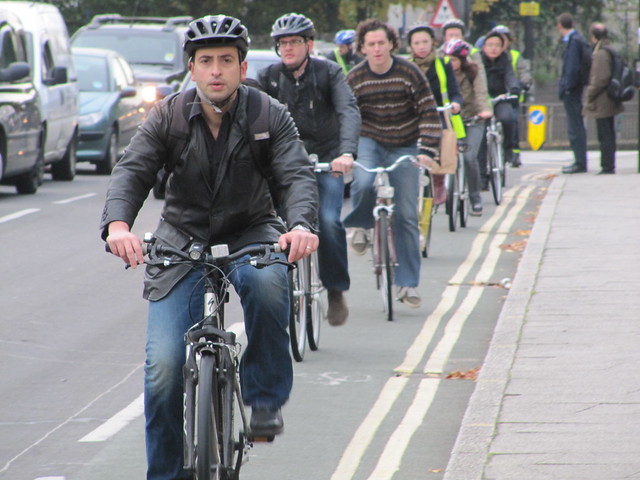
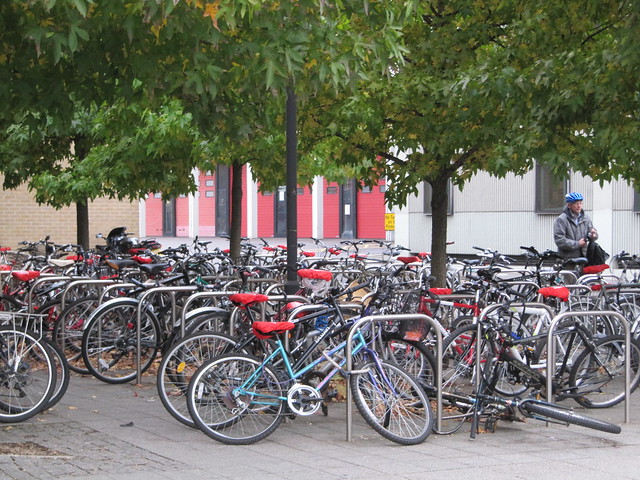
In town there was a fair balance of women and men, which is unusual in the UK where three quarters of all bicycles journeys are undertaken by men. It was fantastic to see a better balance of the sexes on the roads.
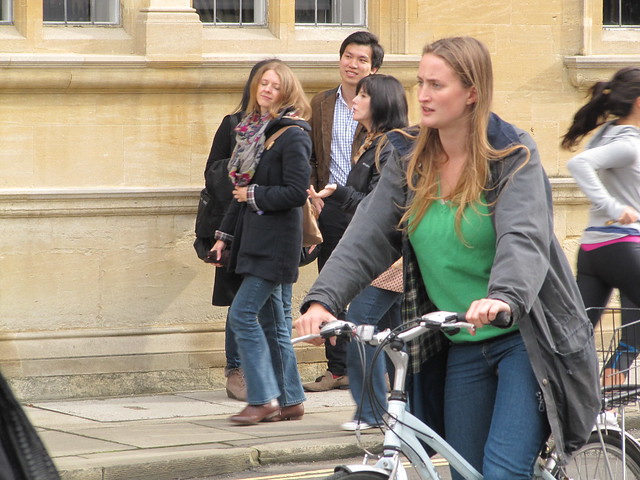
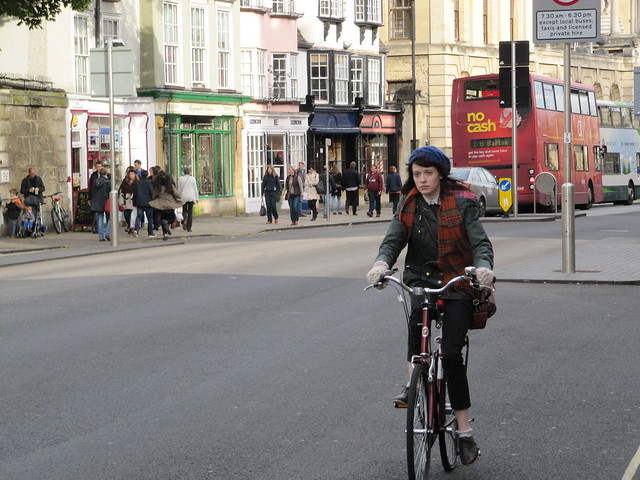

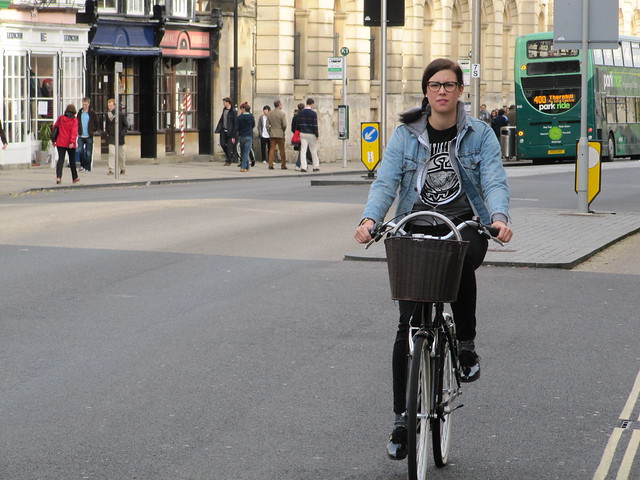
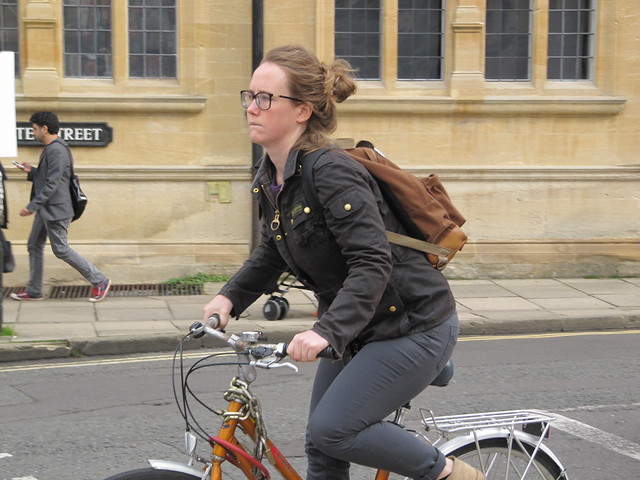
I even spotted a gentleman who looked uncannily like Mark Ronson, singer and composer of The Bike Song. Maybe it was him, who knows?

In the city centre some young (and even some very young) children were being transported by bicycle, which is always a really encouraging sign that a city's streets are safe and inviting enough to allow parents to feel confident enough to ride with their children on board.
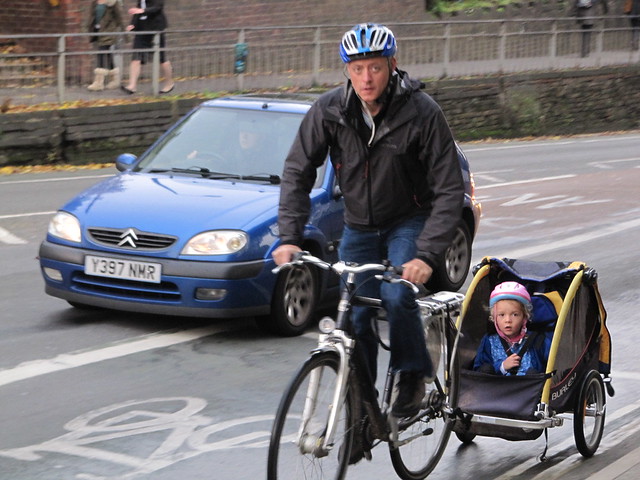
But most excitingly for me, I also saw a healthy number of older people riding bicycles. This is something which in central London - with its relatively younger population - you just don't see as often. When older people feel safe and comfortable riding a bicycle then conditions on the ground are generally good, and of course encouraging more older people to ride can only be a good thing for the city as it helps to give older people independence whilst giving the city more eyes on the street and more mobile customers in return. I even saw one particular lady conducting a side-step dismount of her bicycle at a set of traffic lights, waiting beside her bike whilst the lights changed, and then scooting off and stepping through the bicycle frame as she picked up speed - something I've only ever witnessed on the continent before, and not something I'm sure you could attempt successfully on the Elephant and Castle roundabout.

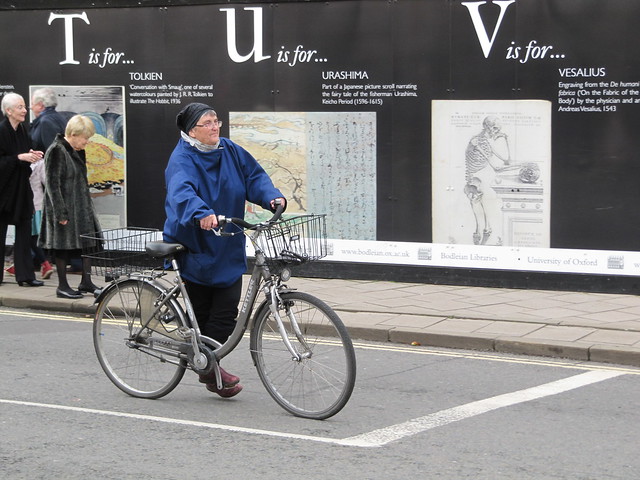

All in all I like Oxford a lot, and I felt that with a little bit of bravery and movement in the right direction it could go from being a good city for pedestrians and cyclists to being a really great city for pedestrians and cyclists. I can just imagine the pages of faux uproar the local newspapers probably turn out every time a new street design or layout proposing one less car parking space is launched, so I can appreciate how hard it can sometimes be for local Councillors. But if we designed all our cities to the agenda of local newspapers they'd be very unpleasant places indeed. Let's hope that Oxford's leaders have got it in them to take the steps the city needs to take to become an even more modern, safe and inviting city for cycling in the future.
Share |
I'd not been to Oxford before, and I wasn't sure what to expect. I half imagined there would be dons in capes on rusty uprights smoking pipes as they darted to the Library by bicycle. But then I realised that's Cambridge. Instead I found a busy city with busy streets, full of conflicting demands for space and supremacy. Some of the city street's carriageways felt unnecessarily wide - and subsequently fast - whilst I was surprised to see quite a bit of on-street parking in the historic city centre. The main road through the middle of the city - the High Street - is an essential bus and bicycle route that allows hundreds of people to come and go without using a car, but the pavements were incongruously narrow and walking here was not exactly a pleasant experience (especially alongside Magdalen College). The cycle lanes there were also narrow, which is why I couldn't understand why so much space had been left over to encourage fast driving. The street design felt very dated, to be honest.


Even the New College Lane passing beneath the so-called "Bridge of Sighs" - surely one of Oxford's most photographed locations - looked decidedly tired with gaudy double yellow lines splashed either side of the narrow road scarred by utility trenches. Seeing as New College Lane is a little-used backway predominantly populated with pedestrians and bicycles, why hasn't this street been surfaced with some beautiful paving, and made in to shared space already so that more people can enjoy it without feeling that what little motorised traffic there is here must take priority?

Still, there are certainly plenty of cyclists to be seen in Oxford and it's charming to see the predominantly young two-wheeled population of the city going about their ways. Most unusually for the UK upright bicycles ruled the day and many bikes were free-locked in the street - something you'd never see in London - which helped to lend a care-free attitude to the city's unencumbered cyclists. The look seemed to be college sports kit, or book bags and long scarves as opposed to high vis vests and helmets, which was refreshing.




Crocodiles of bicycles weaved their way past Oxford train station, the forecourt of which was littered with a mixture of smart commuter frames parked up for the day and the detritus of decades of uncollected dead and dieing bicycles.


In town there was a fair balance of women and men, which is unusual in the UK where three quarters of all bicycles journeys are undertaken by men. It was fantastic to see a better balance of the sexes on the roads.





I even spotted a gentleman who looked uncannily like Mark Ronson, singer and composer of The Bike Song. Maybe it was him, who knows?

In the city centre some young (and even some very young) children were being transported by bicycle, which is always a really encouraging sign that a city's streets are safe and inviting enough to allow parents to feel confident enough to ride with their children on board.

But most excitingly for me, I also saw a healthy number of older people riding bicycles. This is something which in central London - with its relatively younger population - you just don't see as often. When older people feel safe and comfortable riding a bicycle then conditions on the ground are generally good, and of course encouraging more older people to ride can only be a good thing for the city as it helps to give older people independence whilst giving the city more eyes on the street and more mobile customers in return. I even saw one particular lady conducting a side-step dismount of her bicycle at a set of traffic lights, waiting beside her bike whilst the lights changed, and then scooting off and stepping through the bicycle frame as she picked up speed - something I've only ever witnessed on the continent before, and not something I'm sure you could attempt successfully on the Elephant and Castle roundabout.



All in all I like Oxford a lot, and I felt that with a little bit of bravery and movement in the right direction it could go from being a good city for pedestrians and cyclists to being a really great city for pedestrians and cyclists. I can just imagine the pages of faux uproar the local newspapers probably turn out every time a new street design or layout proposing one less car parking space is launched, so I can appreciate how hard it can sometimes be for local Councillors. But if we designed all our cities to the agenda of local newspapers they'd be very unpleasant places indeed. Let's hope that Oxford's leaders have got it in them to take the steps the city needs to take to become an even more modern, safe and inviting city for cycling in the future.
Share |
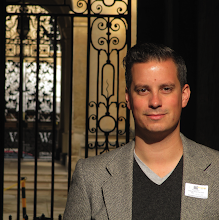



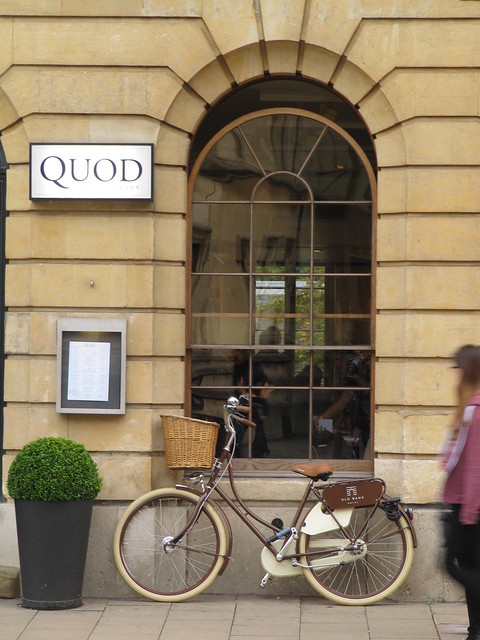
15 comments:
Bike - Medicine for a traffic jam.
Love kid in trailer :)
lovely photos, especially the last one, very copenhagenize
Old don on penultimate picture is Professor Alan Chapman, an expert on the history of astronomy. The Vole will be happy to see him on a bicycle!
Great post Mark, a really interesting look at the city. When I was a student in Oxford I never cycled because I was struck by how congested it was, and how it didn’t seem ideally designed for pedestrians, cars OR bikes. (or to be completely honest because I knew it was only a matter of time before I got on a bike significantly worse for wear after a party or the pub, which would have ended in disaster, or at least significant bruising the next day….)
But now I’ve been cycling happily in London for a good few years I’d probably be less trepidatious. I think the main danger in Oxford is exactly what you spell out – people who imagine that it will be like cycling in a small provincial quite town, rather than in the busy, badly-designed city centre that it is. Also, the large numbers of tourists, often in groups, who wander aimlessly into the road without looking or just generally clog up the small passages and tighter corners of the city for pedestrians and road users alike.
Ach, quiet town, obviously. Sorry for typo.
Thanks everyone for your kind comments.
@hellibird This is the second time someone has recognised a random subject in one of my photographs! When I visited Copenhagen I captured a socialist politician riding their bike on the camera - I had no idea who he was but the people of CPH seemed pleased to see him on a bike! I'm glad that Prffsr Chapman will put a smile on Vole's face.
@AmyUncorked Thanks for your kind comment. I think you'll have to make a return visit - with a bike - and see how those new London cycling skills translate to Oxford and its gaggle of tourists!
Great pictures. I love seeing all the cyclists around that area of the world.
Darryl
I enjoyed this post. I spent in week in Oxford this time last year and was inspired by the number of people on bikes. I agree that the conditions could be improved. I wonder if a large portion of Oxford cyclists are transient students who tolerate the conditions because they know that they will be moving on after a few years.
Ah takes me back! It looks like nothing has changed since the twenty-*cough* years since I was there. When I was a student everyone had a bike - you didn't think anything of it, it was just the only practical way to get around.
Well done Mark.
Good to see that all elderly (i.e. wise) riders do not wear helmets.
@amyuncorked. Don't blame tourists, i.e. foreigners. The fault lies with the authorities which, as Mark clearly shows, do not provide adequate space for pedestrians.
Why are Network Rail so lazy that they don't regularly clean-up bike parking stands and get rid of abandoned bikes?
I visited Oxford last year and hired a bike to get about, and really enjoyed myself. It's noticeable that despite the high number of cyclists, there isn't much in the way of infrastructure, but drivers were generally fairly patient and respectful.
While some of the roads leave a lot to be desired, Oxford is a striking example of what can happen if you limit the amount of car ownership. Because students at the colleges are prevented from keeping cars, they use bikes, and that critical mass helps to support a healthy and diverse bike culture.
Given that bikes and pedestrians make up the majority of street users, I think better provision really should be a no-brainer, but it often comes down to political will, and I imagine that local businesses and non-college residents may feel that they're being restricted by proposals to reallocate space. In the long run, though, it will make things better for everyone!
As an Oxford resident who almost never cycles I would love to see more provision for bicycles and motorbikes in Oxford. More cycle parking is really needed. On the other side we need more responsibility from some people. It is such a lovely place too often ruined by cycles dumped in door ways, and also cars parked on pavements.
Bumped here by your post on Mother's day; a very accurate account of Oxford! I think it is certainly apparent for anyone who lives in Oxford that its high rates and wide variety of cycling is entirely despite infrastructure provision rather than due to some mediocre attempts at it.
Is this a problem? Could there be more people cycling?
I think so. Although anyone heading in from the areas directly around the centre would be likely to cycle, there are a number of peripheral areas with large pools of employment, major supermarkets and leisure facilities, where cycling becomes deeply unattractive.
Up 'the hill' to Headington is potentially a bit of hard work but compounded by some appallingly laid-out roads that pit cyclists against rapidly accelerating and swerving cars, buses and lorries- diving in and out of parked traffic on either side or simply racing between lights alongside narrow, faded cycle lanes. Many people get off and push. Others don't bother and get the bus. Others drive.
With uphill speed differentials and acres of space (albeit currently used for random parking) these routes are crying out for proper 'off road' provision.
Things get far worse towards the noose that is Oxford's ring road. Often there are no crossings for hundreds of metres either way along this dual-carriageway and cyclists are forced alongside on low-grade, polluted paths until the inevitable roundabout or underpass where they can dismount and attempt a multi-stage crossing.
For me, the undeniable joy of dutch-style school runs and grannies on shoppers in the city back-streets is soured by the knowledge that this is one UK city where cycling is already a widespread cultural norm. How pathetically this has been furthered or encouraged. Oxford should be a shining beacon for simple, utilitarian cycling. Unfortunately, outside the student and inner city population, the car is king and Oxford is no different to any other part of Southern England.
For a leisurely pootle to the library you can't beat it but for the lengthy commute on a drizzly Monday give me London and it's luxurious bus lanes every time.
(Oh, and as in Cambridge, I think it is a misconception that a ban on student parking makes any real difference. Residential parking is already so tight that it is very difficult to park in the areas where students generally live. Mostly impossible near the ancient colleges. No University enforcement is necessary.)
Post a Comment